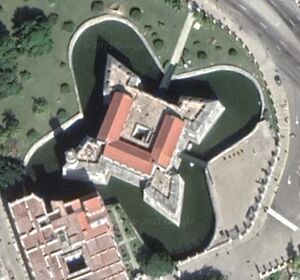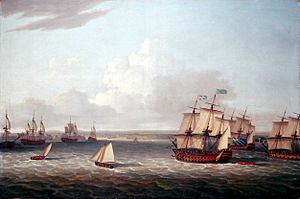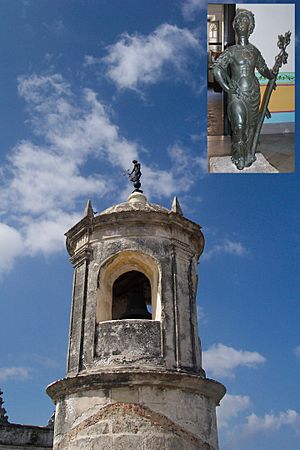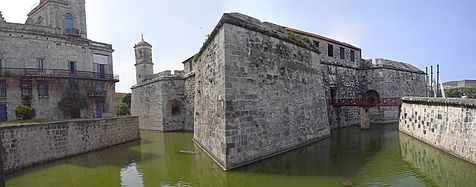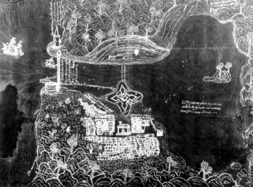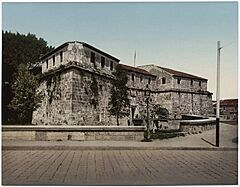Castillo de la Real Fuerza facts for kids
 |
|
Quick facts for kids General information |
|
|---|---|
| Groundbreaking | 1558 |
| Completed | 1577 |
| Technical details | |
| Structural system | Load bearing |
| Material | Masonry |
The Castillo de la Real Fuerza (which means Castle of the Royal Force) is an old stone fort in Havana, Cuba. It sits on the western side of Havana's harbor, a bit away from the entrance, and is next to the Plaza de Armas. This fort was first built to protect the city from pirate attacks. However, its location was not ideal because it was too far inside the bay. The Castillo de la Real Fuerza is thought to be the oldest stone fort in the Americas. In 1982, it became part of the UNESCO World Heritage Site called "Old Havana and its Fortifications".
Contents
History of the Fort
Before this fort, there was an older one called the Fuerza Vieja (Old Fort). It was damaged in 1555 when a French privateer named Jacques de Sores attacked Havana. The Old Fort was later taken down in 1582.
In 1558, Bartolomé Sánchez, an engineer sent by King Philip II of Spain, started building a new fort. It was first known as the Fuerza Nueva (New Fort). The plan was to build it closer to the harbor than the old one. Work on the iron parts began in 1558, but the first stones were not laid until 1562.
Building the fort faced many delays. Local people had to move, and there were disagreements between Sánchez and the Governor of Havana. The fort was finally finished in 1577. Most of the work was done by slaves and French prisoners. The fort was made from limestone found along the Havana shoreline. It had thick, sloped walls, a moat, and a drawbridge.
The governor, Francisco Carreño, ordered an upper floor to be added for soldiers' living quarters and a place to store weapons. However, once it was finished, the fort turned out to be too small for its intended use.
Even though it was closer to the harbor than the Fuerza Vieja, the new fort was still too far from the harbor's entrance to defend it well. Because of this, Juan de Tejeda decided to use it as the home for the Governor of Havana instead. Later governors made more changes to the building. In 1851, part of the fort's front was removed. This allowed O’Reilly Street to reach the docks and kept the fort from blocking the view of El Templete, a monument built in 1828.
Cuba's Challenges (1500s - 1700s)
Colonial Cuba was often attacked by buccaneers, pirates, and French corsairs. These groups wanted Spain's riches from the New World. To stop these attacks, Spain built stronger defenses across the island during the 1500s. In Havana, the Castillo de los Tres Reyes Magos del Morro fort was built to keep invaders away. One famous English privateer, Francis Drake, sailed near Havana but did not land.
In 1628, Havana's defenses were shown to be weak when a Dutch fleet, led by Piet Heyn, stole Spanish ships from the city's harbor. In 1662, the English pirate Christopher Myngs captured Santiago de Cuba for a short time. This was an attempt to open up Cuba's trade with nearby Jamaica.
About a century later, the British Royal Navy tried another invasion. They captured Guantánamo Bay in 1741 during the War of Jenkins' Ear with Spain. The British admiral, Edward Vernon, had 4,000 troops, but they faced attacks from Spanish soldiers and a serious illness. This forced the British to leave and return to British Jamaica. In the War of the Austrian Succession, the British tried to attack Santiago de Cuba in 1741 and again in 1748, but they were not successful. There was also a small naval battle near Havana in 1748.
The Seven Years' War started in 1754 and spread across three continents. It eventually reached the Spanish Caribbean. Spain joined forces with the French, which put them in direct conflict with the British. In 1762, a British force of five warships and 4,000 troops sailed from Portsmouth to capture Cuba. The British arrived on June 6 and had Havana surrounded by August.
When Havana surrendered, the British admiral, George Keppel, became the new governor. He took control of the entire western part of the island. The British arrival quickly opened up trade between Cuba and their colonies in North America and the Caribbean. This caused big changes in Cuban society.
Havana had become the third-largest city in the Americas. During this time, it grew a lot and formed closer ties with North America. However, the British control of Havana did not last long. Sugar merchants in London worried that sugar prices would drop. This led to talks between the British and Spanish about their colonies. Less than a year after Havana was taken, the Peace of Paris was signed in 1763. This treaty ended the Seven Years' War. Britain received Florida from Spain in exchange for Cuba. France had advised Spain to accept this deal, fearing Spain might lose Mexico and much of South America to the British otherwise. In 1781, General Bernardo de Gálvez, the Spanish governor of Louisiana, took back Florida for Spain with troops from Mexico, Puerto Rico, the Dominican Republic, and Cuba.
Isabel de Bobadilla: Cuba's First Female Governor
Isabel de Bobadilla (also known as Inés de Bobadilla), who lived from about 1505 to 1554, was the first female governor of Cuba. She held this important role from 1539 to 1543.
Family Connections
Isabel came from a family deeply involved in exploring and conquering the Americas. She was the third child of Pedro de Arias and Isabel de Bobadilla y Peñalosa. Her father, Pedro de Arias, was one of the conquerors of Central America and also the governor of Nicaragua. Isabel's mother was the niece of Beatriz de Bobadilla, a close friend of Isabella I of Castile. Beatriz was the head of two very powerful and wealthy families in Spain, the Bobadillas and Peñalosas. Isabel de Bobadilla (the daughter) was also the granddaughter of Francisco de Bobadilla. He was chosen to take over from Christopher Columbus as the second governor of the Indies in 1499.
Marriage and Wealth
In 1537, Isabel de Bobadilla married Hernando de Soto, a famous explorer and conquistador. He led one of the first European expeditions into what is now the United States. When she married, Isabel was likely in her late twenties or early thirties. This was a bit older than typical for women from powerful families at that time.
A document from November 14, 1536, called the "Conveyance of Dower," shows the wealth of Isabel's family. It listed all the cattle, land, slaves, and horses that belonged to Pedro de Arias in Panama. This document proves that Isabel's marriage to de Soto was also a business deal. It connected a very powerful Spanish family with an established conquistador.
Hernando de Soto was named governor of Cuba and Adelantado de Florida. They both arrived in Cuba in 1538. Records show that Isabel brought her slaves to Cuba, including three white slaves who were Christians. Within a few weeks of 1539, the couple bought at least four plantations near Havana. The largest one was at Cojimar, on the coast east of the bay.
Leading Cuba
On May 17, 1539, Isabel de Bobadilla was given power to govern Cuba. This happened when Hernando de Soto left Havana to explore and conquer Florida. De Soto also appointed Juan de Rojas as Isabel's deputy in Havana and Francisco de Guzman as her deputy in Santiago. Both men had served in these roles before de Soto and Bobadilla arrived.
At that time, many powerful groups were competing for control in Spain through exploring new lands. Important figures in these "grand plans of exploration" included Alvar Nunez Cabeza de Vaca, Hernán Cortés, Pedro de Alvarado, Hernando de Soto, and Antonio de Mendoza. This shows that Isabel de Bobadilla was given a very important and political role.
Historians have different ideas about why Isabel de Bobadilla was made governor. Some believe de Soto simply did not want to stay in Cuba. However, surviving documents show that Isabel was the governor both officially (de jure) and in practice (de facto). Rodrigo Ranjel, de Soto's private secretary, said Isabel had her mother's strength, intelligence, and strong character. He described her as "a woman of great essence and goodness, and of very noble judgment and character." De Soto himself confirmed Isabel's abilities by giving her power of attorney and naming her governor of Cuba.
In 16th-century Spain, it was very rare for a woman to hold such a high position. Isabel became the first female governor of Cuba and the first woman governor of a territory in the Western Hemisphere. The only other woman in a high office in the Spanish colonies during that century was Aldonza Manrique of Venezuela. She became governor when her father, Marcelo Villalobos, died in 1526. The King of Spain also recognized Bobadilla as governor in letters sent directly to her.
As governor, Isabel handled many challenges faced by New World governors. These included problems between the native Cubans and the Europeans. Isabel Bobadilla helped make Cuba stronger against enemies by pushing forward the building of Havana's first fortress, La Fuerza. La Fuerza was finished by Isabel de Bobadilla to defend the city from frequent enemy attacks. However, French pirates led by Jacques de Sores still attacked Havana and burned La Fuerza in 1555.
Death and Legacy
In December 1543, Rodrigo Arangel brought news to Isabel in Havana that her husband, the explorer and conquistador Hernando de Soto, had died. After his death, Isabel sold thousands of items belonging to her and her husband before she left Cuba for Spain. These items included a ranch, native laborers, hundreds of cattle, and 500 yucca plants. She also sold Soto’s house in Havana, which had eighteen household slaves, a rosary made of thirty-two solid-gold beads, and a black velvet collar and cap. By selling these items, she raised "more than four thousand pesos of gold," which she used to move back to Spain.
The exact details of Isabel de Bobadilla's death are not clear. Some people say she moved back to Spain with the money she received. Others believe that after she heard of her husband's death, she was "broke with grief" and died a few days later.
La Giraldilla: A Symbol of Havana
In 1634, Juan Vitrián de Viamonte added a watchtower to the fort. On top of it, he placed a weathervane shaped like a woman. This sculpture was made by Gerónimo Martín Pinzón, an artist from Havana. It was inspired by the figure that crowns La Giralda in Seville, Spain.
The reason for choosing this specific figure, called La Giraldilla, is not fully known. However, a common belief is that it honors Isabel de Bobadilla. She was Havana's only female governor. She took control when her husband, Hernando de Soto, left for an expedition to Florida. It is said that she spent many years looking out at the horizon, hoping to see his ship return. Sadly, she did not know he had already died.
This figure became a symbol of the city of Havana. You can even see it on the Havana Club rum label. The original La Giraldilla is now kept in the City Museum, which is located in the Palacio de los Capitanes Generales in the Plaza de Armas. The figure you see on the watchtower today is a copy.
What the Fort is Used For Now
The Castillo de la Real Fuerza has had many different uses over the years. From 1899, it was home to the National Archive. Then, from 1938 until 1957, it housed the National Library. Both of these were later moved to a new, specially built library in Plaza de la Revolución.
After the Cuban Revolution in 1959, the fort became home to the offices of the National Commission of Monuments and the Centre of Preservation, Restoration, and Museology. For a short time, it was also a Museum of Arms. However, the conditions inside the fort were not good for keeping the displays safe.
In 1977, on the 400th anniversary of its completion, the building was opened as a museum. It showed exhibitions of Cuban and international modern art. In 1990, it became the National Museum of Cuban Ceramics.
In 2010, the Castillo de la Real Fuerza reopened as Cuba's maritime museum. This museum shows Cuba's history with the sea, from before Columbus arrived up to the 1700s. It highlights the Royal Shipyard of Havana, which was one of the biggest in the world. This shipyard built nearly 200 ships for the Spanish Crown.
The museum features a huge four-meter model of the Santisima Trinidad. This model is on the main floor and has a large interactive touch screen in Spanish, French, and English. The exhibit describes what life was like on an 18th-century warship. The original ship was launched into Havana Bay on March 2, 1769. It was the largest ship in the world in the 1700s, with 140 cannons on four gun decks. It was one of four Cuban-built ships that fought in the Battle of Trafalgar in 1805.
The exhibits downstairs include old navigation tools, artifacts found underwater, and gold and silver from the colonial era. The museum also has the original La Giraldilla weathervane, while a copy is on top of the fort's tower. The second level of the museum displays many other historical and modern ship models connected to Cuba. It also offers great views of the harbor and the city skyline.
Gallery
See also
 In Spanish: Castillo de la Real Fuerza de La Habana para niños
In Spanish: Castillo de la Real Fuerza de La Habana para niños
- List of buildings in Havana
- Treaty of Paris (1763)
- Batería de la de la Reina
- Castillo San Salvador de la Punta
- Santa Clara Battery
- Castillo del Príncipe (Havana)
- Torreón de San Lázaro
- La Cabaña
- Castillo de Atarés
- Timeline of Havana


